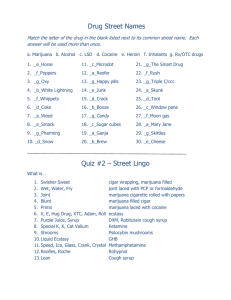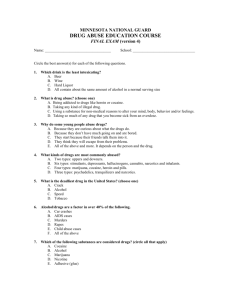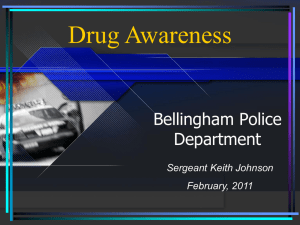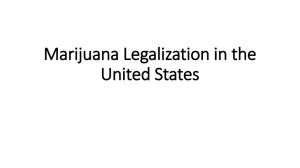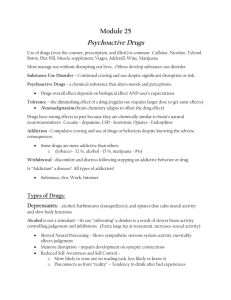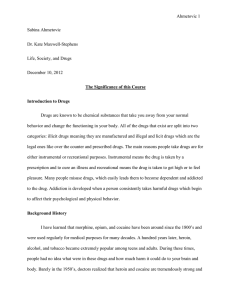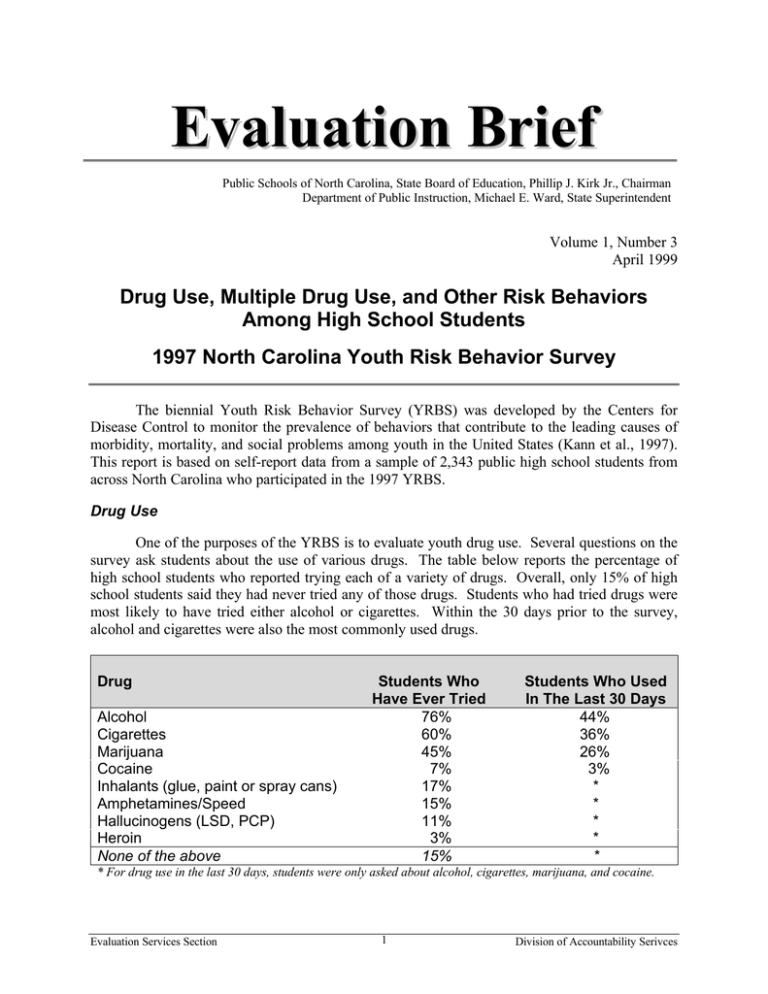
Evaluation Brief
Public Schools of North Carolina, State Board of Education, Phillip J. Kirk Jr., Chairman
Department of Public Instruction, Michael E. Ward, State Superintendent
Volume 1, Number 3
April 1999
Drug Use, Multiple Drug Use, and Other Risk Behaviors
Among High School Students
1997 North Carolina Youth Risk Behavior Survey
The biennial Youth Risk Behavior Survey (YRBS) was developed by the Centers for
Disease Control to monitor the prevalence of behaviors that contribute to the leading causes of
morbidity, mortality, and social problems among youth in the United States (Kann et al., 1997).
This report is based on self-report data from a sample of 2,343 public high school students from
across North Carolina who participated in the 1997 YRBS.
Drug Use
One of the purposes of the YRBS is to evaluate youth drug use. Several questions on the
survey ask students about the use of various drugs. The table below reports the percentage of
high school students who reported trying each of a variety of drugs. Overall, only 15% of high
school students said they had never tried any of those drugs. Students who had tried drugs were
most likely to have tried either alcohol or cigarettes. Within the 30 days prior to the survey,
alcohol and cigarettes were also the most commonly used drugs.
Drug
Alcohol
Cigarettes
Marijuana
Cocaine
Inhalants (glue, paint or spray cans)
Amphetamines/Speed
Hallucinogens (LSD, PCP)
Heroin
None of the above
Students Who
Have Ever Tried
76%
60%
45%
7%
17%
15%
11%
3%
15%
Students Who Used
In The Last 30 Days
44%
36%
26%
3%
*
*
*
*
*
* For drug use in the last 30 days, students were only asked about alcohol, cigarettes, marijuana, and cocaine.
Evaluation Services Section
1
Division of Accountability Serivces
Age at Which Students First Use Various Drugs
A common concern with drug use among children is whether certain substances might
serve as “gateway drugs”, leading to the use of other substances (Ellickson, Hays, & Bell, 1992;
Lindsay & Rainey, 1997; Torabi, Bailey, & Majd-Jabbari, 1993). The 1997 YRBS high school
data suggest that first instances of smoking and alcohol use tend to occur at about the same time.
Both smoking, alcohol use, and marijuana use, however, tend to precede the onset of cocaine
use. Interestingly, high school students in report a later onset of drug use than do middle school
students according to 1997 YRBS data (North Carolina Department of Public Instruction, 1999).
Although this may suggest that middle school students are initiating drug use earlier than their
older counterparts, it may also be due to less accurate recall among high school students (as this
event may have occurred several years in the past for many high school students).
It is important to note that the data below do not show that smoking or alcohol use or
marijuana use cause cocaine use; the data merely show that among students who use multiple
drugs, the first incidences of smoking, alcohol use, and marijuana use tend to occur earlier in
students’ lives than the first incidence of cocaine use.
Age of Onset of Drug Use
Average (median) age when a student first:
• tries alcohol:
13-14
• tries a cigarette:
13-14
• tries marijuana:
13-14
• tries cocaine:
15-16
Cigarettes and Cocaine
Among high school students who reported that they had tried both cigarettes and cocaine:
• 71% tried cigarettes first before trying cocaine
• 12% tried cocaine first before trying cigarettes
Alcohol and Cocaine
Among high school students who reported that they had tried both alcohol and cocaine:
• 71% tried alcohol first before trying marijuana
• 9% tried marijuana first before trying cigarettes
Marijuana and Cocaine
Among high school students who reported that they had tried both marijuana and cocaine:
• 60% tried marijuana first before trying cocaine
• 10% tried cocaine first before trying marijuana
Evaluation Services Section
2
Division of Accountability Serivces
Patterns of Multiple Drug Use
Research has shown that youth who abuse one drug are more likely to also abuse other
drugs (Block & Goodman, 1978; Kaufman, 1976; Martin, Arria, Mezzich, & Bukstein, 1993).
The YRBS also provides information which addresses this issue. The table below reports the
percentage of high school students who reported using multiple drugs (alcohol, cigarettes,
marijuana, cocaine) within the past 30 days. Less than half (47%) of students reported that they
did not use alcohol, cigarettes, marijuana or cocaine in the past month. Over half (60%) of the
students who reported having used any of those drugs, however, used more than one.
Number Of Drugs
Students Who Used
In The Last 30 Days
47%
21%
17%
15%
None of these drugs
1
2
3 or 4
The following data1 provide some information on the use of multiple specific drugs.
Cigarettes and Other Drugs
Compared to nonsmokers, high school students who smoke cigarettes:
• are 17 times more likely to use cocaine
• are 5 times more likely to use marijuana
• are 3 times more likely to use alcohol
Alcohol and Other Drugs
Compared to nondrinkers, high school students who drink alcohol:
• are 53 times more likely to use cocaine
• are 6 times more likely to use marijuana
Marijuana and Other Drugs
Compared to students who do not use marijuana, high school students who do use marijuana:
• are 43 times more likely to use cocaine
1
These co-occurrence data were calculated by dividing the percentage of users who used a second drug by the
percentage of non-users who used that same second drug. “Use” is defined as having used a particular drug at least
once within the last 30 days.
Evaluation Services Section
3
Division of Accountability Serivces
Multiple Drug Use and Other Risk Behaviors
Previous studies have shown that the use of multiple drugs is associated with other
undesirable factors, such as delinquency, suicidal thoughts, and general “risk-taking” personality
traits (Adlaf & Smart, 1983; Smith, Schwartz, & Martin, 1989; Wright, 1985). The following
figures based on YRBS data provide a descriptive look at some potential relationships between
multiple drug use (alcohol, cigarettes, marijuana and/or cocaine within the last 30 days) and the
prevalence of other risk behaviors among high school students.
Percent of Students
Vehicle Safety
Percentage of high school students who reported “never” or “rarely” wearing a helmet while
riding a bike or a motorcycle:
Bicycle
Motorcycle
1 drug
2 drugs
100
90
80
70
60
50
40
30
20
10
0
Non-users
3 or more
Percentage of high school students who reported that they “never” or “rarely” wear a seatbelt in a
car, percentage who had ridden in a car with a drinking driver in the past month, and percentage
who reported that they had driven a car after drinking in the past month:
Never/Rarely Wear Seatbelt
Ride w/ Drinking Driver
Drive After Drinking
Percent of Students
80
70
60
50
40
30
20
10
0
Non-users
Evaluation Services Section
1 drug
2 drugs
4
3 or more
Division of Accountability Serivces
Violence
Percentage of high school students who were in a fight or were hurt in a fight in the past year:
Been in a Fight
Been Hurt in Fight
Percent of Students
80
70
60
50
40
30
20
10
0
Non-users
1 drug
2 drugs
3 or more
Suicidal Behavior
Percentage of high school students who have ever considered, planned, or attempted suicide, and
percentage of students who had been injured in a suicide attempt:
Considered Suicide
Attempted Suicide
Planned Suicide
Injured in Suicide Attempt
Percent of Students
80
70
60
50
40
30
20
10
0
Non-users
Evaluation Services Section
1 drug
2 drugs
5
3 or more
Division of Accountability Serivces
Carrying Weapons
Percentage of high school students who reported carrying weapons in the past 30 days:
Carried a Gun
Carried Gun in School
Carried Any Weapon in School
Carried Any Weapon
80
Percent of Students
70
60
50
40
30
20
10
0
Non-users
1 drug
2 drugs
3 or more
Sexual Behavior
Percentage of high school students who reported having sexual intercourse before age 14,
percentage who reported having had a sexually transmitted disease, percentage who had been
involved in a pregnancy, and percentage who had intercourse with more than 1 person in the past
3 months:
Sex Before Age 14
STD
Involved in Pregnancy
More Than 1 Partner
Percent of Students
80
70
60
50
40
30
20
10
0
Non-users
Evaluation Services Section
1 drug
2 drugs
6
3 or more
Division of Accountability Serivces
Self-Reported Achievement and Academic Aspirations
Percentage of high school students who reported performing below the “C” level overall on their
last report card, and percentage who intend on pursuing any form of post-secondary education:
Performing Below "C" Level
Planning on Higher Education
Percent of Students
80
70
60
50
40
30
20
10
0
Non-users
1 drug
2 drugs
3 or more
Summary
Data from the 1997 Youth Risk Behavior Survey help to shed light on the nature of drug
use among North Carolina high school students. Specifically:
• For high school students who have tried drugs, initiation of drug use occured, on average, at
about 13-14 years of age.
• Approximately 53% of high school students used some drug at least once in the past month.
• Of those students who had used selected drugs in the past month, 60% reported using multiple
drugs during that period.
• Multiple drug use appears to be associated with a variety of risk behaviors, including less
frequent use of helmets and seatbelts, fighting, drinking and driving, riding with drinking
drivers, suicidal behavior, carrying weapons, risky sexual behavior and low grades.
Schools need to be aware that a student who uses drugs may also be engaging in a variety
of other behaviors that may be detrimental to her/his health and development. Therefore,
comprehensive intervention approaches may be needed for these students which focus not just on
drug abuse, but on a range of behaviors in order to lessen their risk of becoming involved in
dangerous and even life-threatening events.
This information on drug use among high school students helps to quantify and reiterate
an important point: Preventing drug use is a critical step in ensuring the health and well-being of
children. The prevalence of multiple drug use among high school students, the potential
associations between multiple drug use and other risk behaviors, and the lower academic
achievement seen among multiple drug users further reinforce the long-standing need for risk
behavior prevention and intervention efforts targeting young children and adolescents.
Evaluation Services Section
7
Division of Accountability Serivces
References
Adlaf, E. M., & Smart, R. G. (1983). Risk-taking and drug-use behavior: An
examination. Drug and Alcohol Dependence, 11, 287-296.
Block, J. R., & Goodman, N. (1978). Illicit drug use and consumption of alcohol,
tobacco, and over-the-counter medicine among adolescents. International Journal of the
Addictions, 13, 933-946.
Ellickson, P. L., Hays, R. D., & Bell, R. M. (1992). Stepping through the drug use
sequence: Longitudinal scalogram analysis of initiation and regular use. Journal of Abnormal
Psychology, 101, 441-451.
Kann, L., Kinchen, S. A., Williams, B. I., Ross, J. G., Lowry, R., Hill, C. V., Grunbaum,
J. A., Blumson, P. S., Collins, J. L., Kolbe, L. J., & State and Local YRBSS Coordinators.
(1998). Youth risk behavior surveillance – United States, 1997. Journal of School Health, 68,
355-369.
Kaufman, E. (1976). The abuse of multiple drugs I: Definition, classification, and
extent of problem. American Journal of Drug and Alcohol Abuse, 3, 279-292.
Lindsay, G. B., & Rainey, J. (1997). Psychosocial and pharmacologic explanations of
nicotine’s “gateway drug” function. Journal of School Health, 67, 123-126.
Martin, C. S., Arria, A. M., Mezzich, A. C., & Bukstein, O. G. (1993). Patterns of
polydrug use in adolescent alcohol abusers. American Journal of Drug and Alcohol Abuse, 19,
511-521.
North Carolina Department of Public Instruction. (1999). Drug use, multiple drug use,
and other risk behaviors among middle school students (Evaluation Brief vol. 1 issue 1).
Raleigh, NC: North Carolina Department of Public Instruction.
Smith, D. E., Schwartz, R. H., & Martin, D. M. (1989). Heavy cocaine use by
adolescents. Pediatrics, 83, 539-542.
Torabi, M. R., Bailey, W. J., & Majd-Jabbari, M. (1993). Cigarette smoking as a
predictor of alcohol and other drug use by children and adolescents: Evidence of the “gateway
drug” effect. Journal of School Health, 63, 302-306.
Wright, L. S. (1985). High school polydrug users and abusers. Adolescence, 20, 853861.
Evaluation Services Section
8
Division of Accountability Serivces

